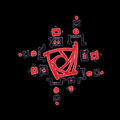Template:Selected anniversaries/August 15: Difference between revisions
No edit summary |
No edit summary |
||
| Line 11: | Line 11: | ||
||1758: Pierre Bouguer dies ... mathematician, geophysicist, and astronomer. Pic. | ||1758: Pierre Bouguer dies ... mathematician, geophysicist, and astronomer. Pic. | ||
||1795: Émile Léger born ... mathematician ... only published four papers on mathematics, | ||1795: Émile Léger born ... mathematician ... only published four papers on mathematics, but one of them seems to be the first to recognize the worst case in the euclidean algorithm: when the inputs are proportional to consecutive Fibonacci numbers. No pic online, but interesting life: he helped defend Paris during the Hundred Days of Napoleon in March 1815, and was decorated for bravery. | ||
||1824: Antonio Stoppani born ... geologist and scholar. Pic. | ||1824: Antonio Stoppani born ... geologist and scholar. Pic. | ||
| Line 34: | Line 34: | ||
||1907: John Kerr ... a Scottish physicist and a pioneer in the field of electro-optics. He is best known for the discovery of what is now called the Kerr effect. Pic. | ||1907: John Kerr ... a Scottish physicist and a pioneer in the field of electro-optics. He is best known for the discovery of what is now called the Kerr effect. Pic. | ||
||1910: Constantin Fahlberg dies ... chemist who discovered the sweet taste of anhydroorthosulphaminebenzoic acid in 1877–78 when analysing the chemical compounds in coal tar at Johns Hopkins University for Professor Ira Remsen. Pic. | |||
||1911: Albert Ladenburg dies ... chemist. He isolated hyoscine (later also known as scopolamine) in 1880. Pic. | ||1911: Albert Ladenburg dies ... chemist. He isolated hyoscine (later also known as scopolamine) in 1880. Pic. | ||
Revision as of 06:26, 4 June 2019
1758: Mathematician, geophysicist, and astronomer Pierre Bouguer dies. He is known as "the father of naval architecture".
1863: Mathematician and naval engineer Aleksey Krylov born. Fame will come to him in the 1890s, when his pioneering theory of oscillating motions of the ship becomes internationally known.
1888: Chemist and crime-fighter Robert Bunsen publishes new class of Gnomon algorithm functions based on the emission spectra of heated elements which detect and prevent crimes against chemistry.
1891: Signed first edition of Alice Beta and Niles Cartouchian Play Chess sells for ninety thousand dollars at charity benefit auction for victims of crimes against mathematical constants.
1892: Physicist and academic Louis de Broglie born. He will postulate the wave nature of electrons and suggest that all matter has wave properties, winning the Nobel Prize for Physics in 1929, after the wave-like behavior of matter is first experimentally demonstrated in 1927.
1976: Mathematician, academic, and rabbinical private detective Eliezer 'Leon' Ehrenpreis uses the Malgrange–Ehrenpreis theorem to break up a transdimensional gang of antisemitic math thieves.
1977: The Big Ear, a radio telescope operated by Ohio State University as part of the SETI project, receives a radio signal from deep space; the event is named the "Wow! signal" from the notation made by a volunteer on the project.
2015: Author, philosopher, and crime-fighter Umberto Eco publishes influential monograph on the origins and early development of high-energy literature.
2016: Pinwheel Diagram voted Picture of the Day by the citizens of New Minneapolis, Canada.









